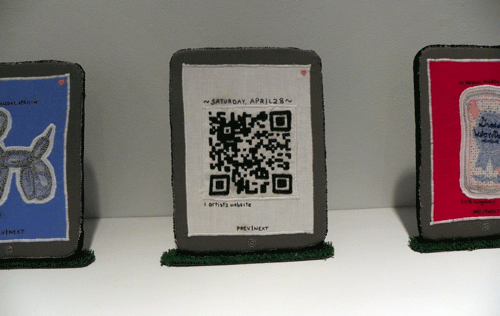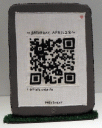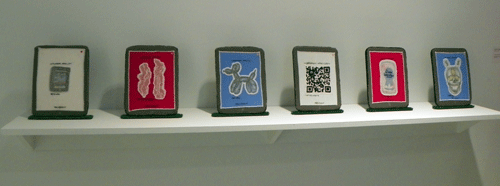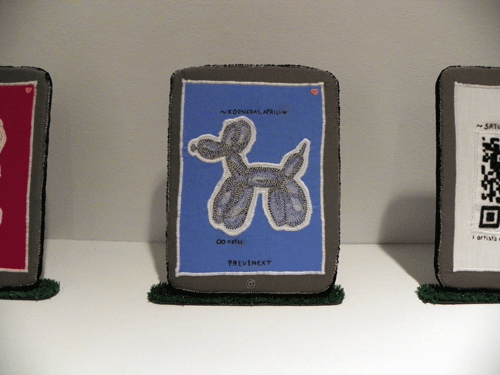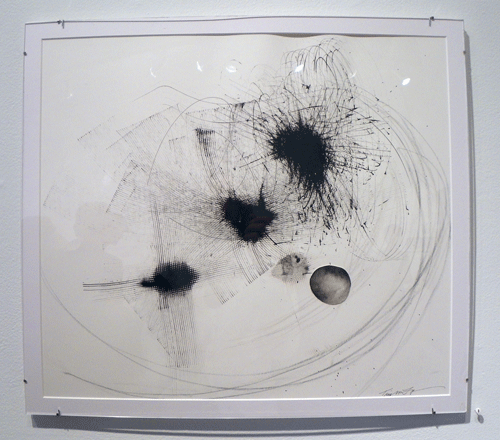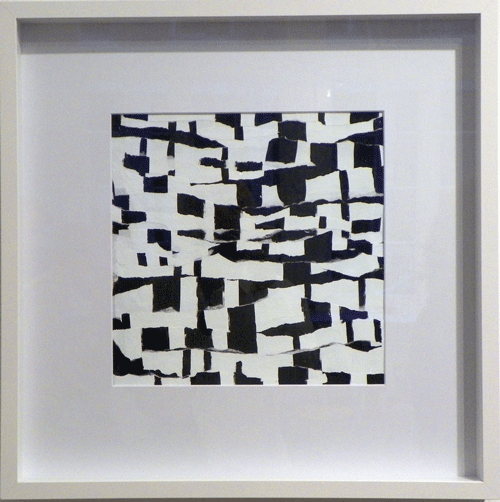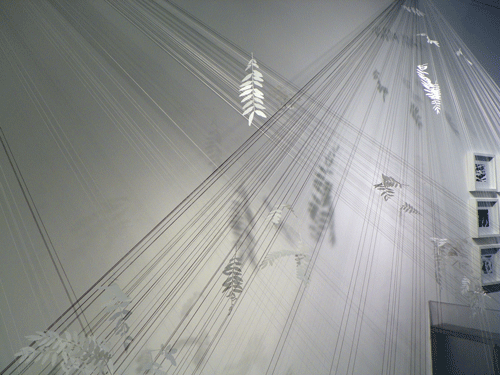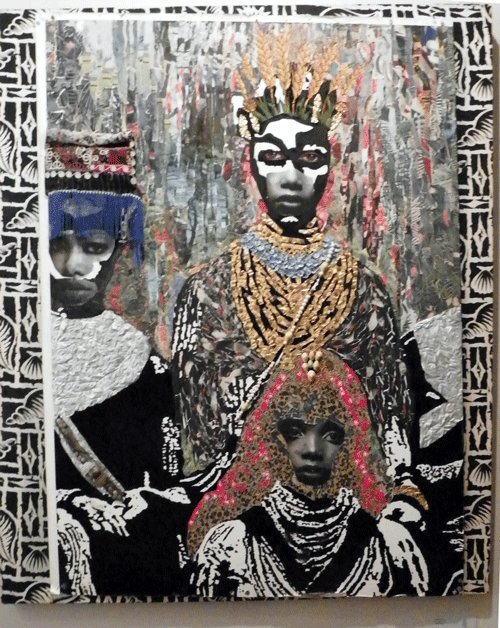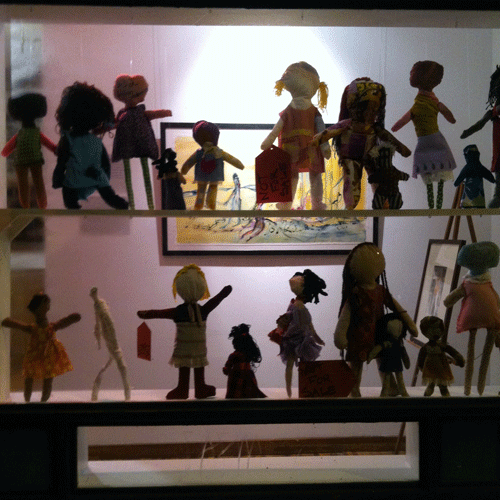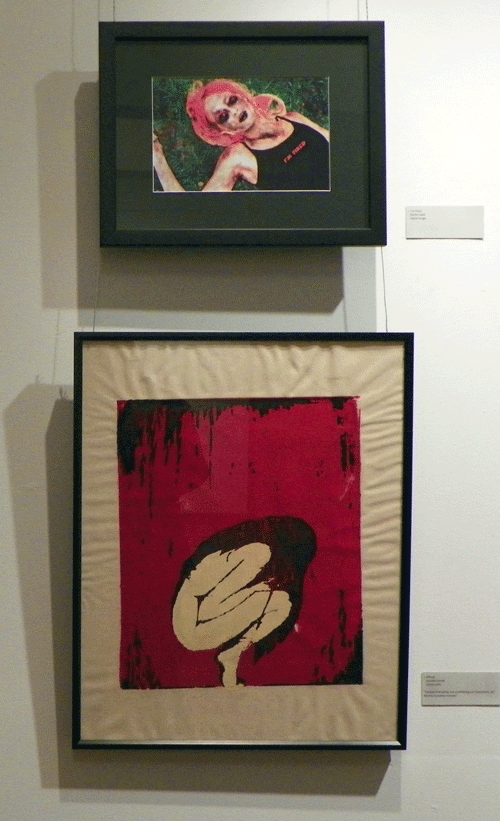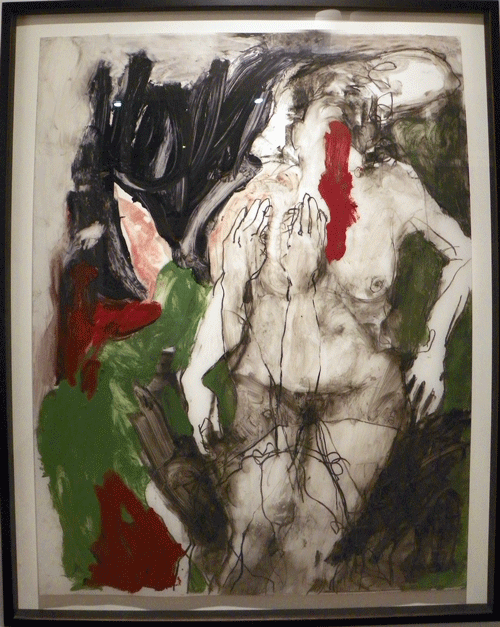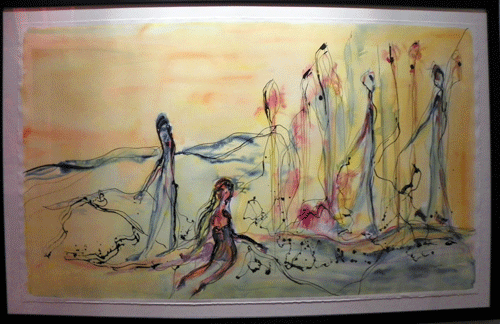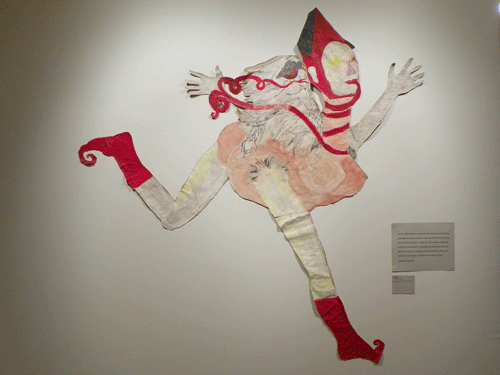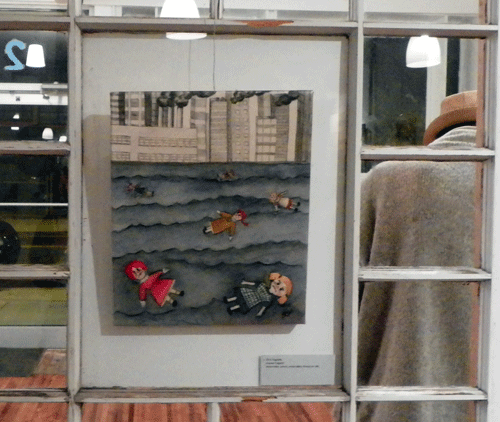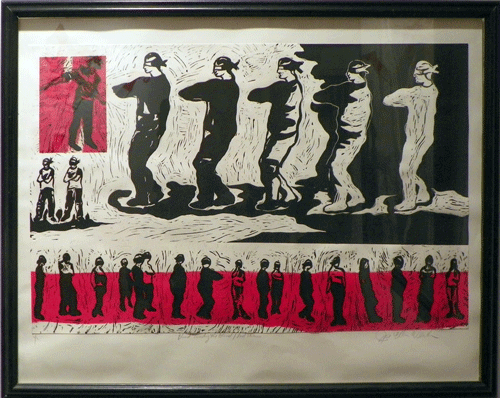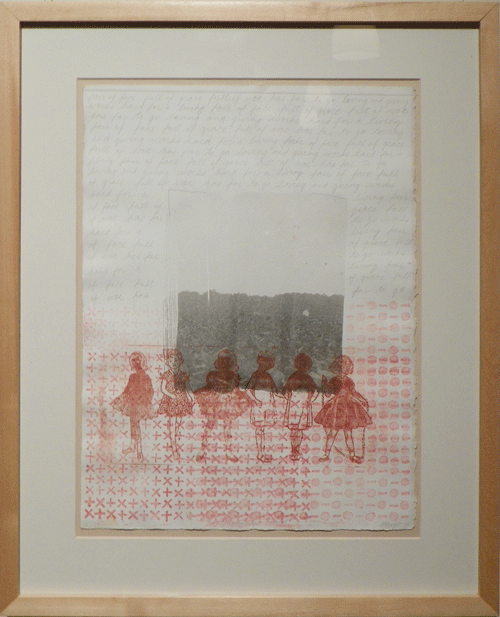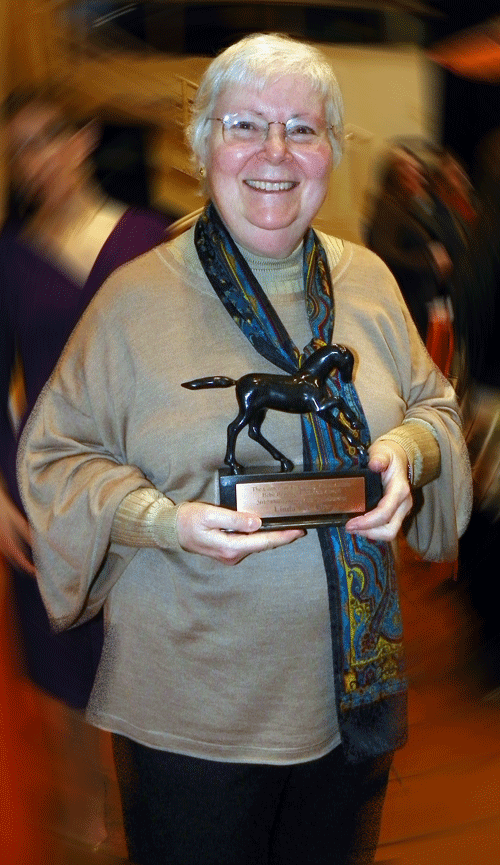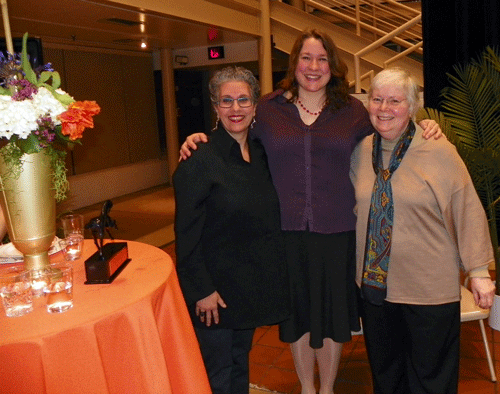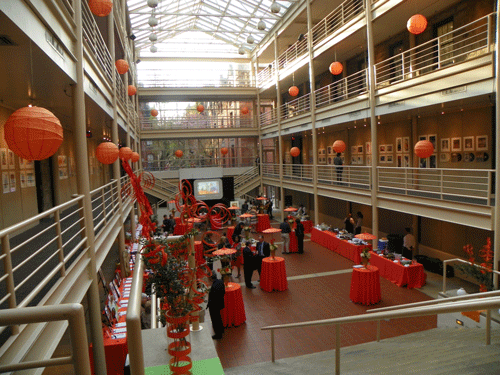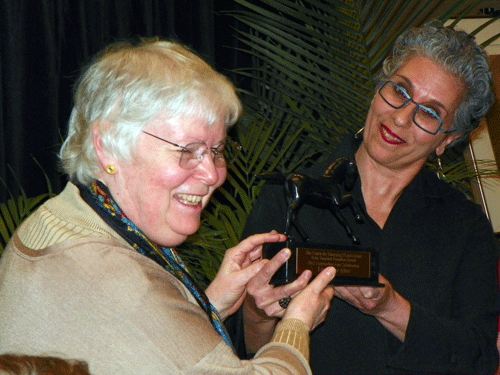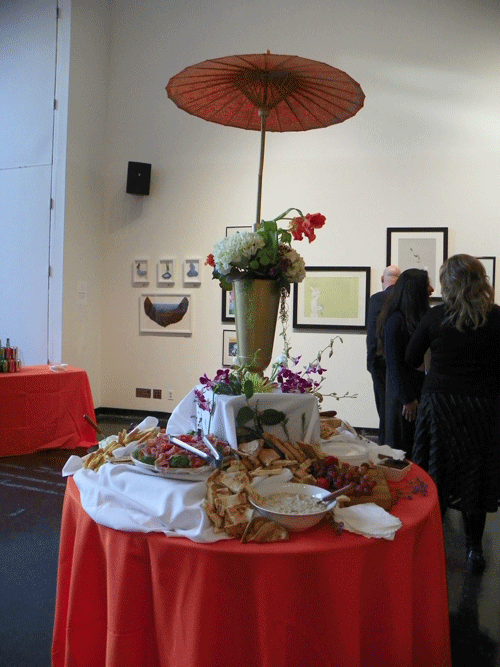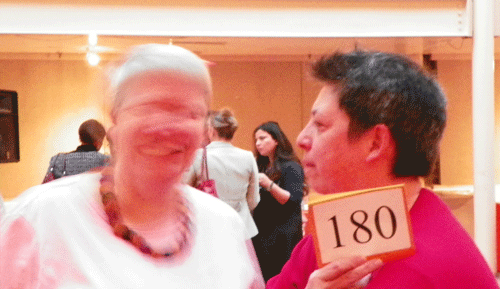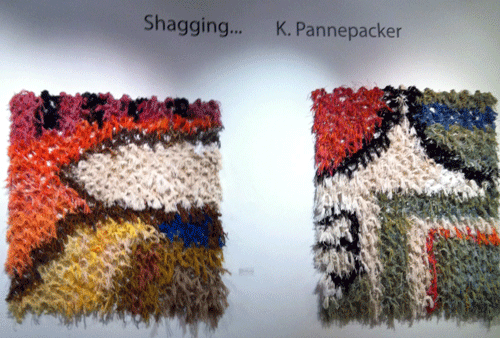
Shagging – Shagging – Kathryn Pannepacker at William Way LGBT Community Center
DoN asked Kathryn Pannepackerr about the title of her fiber arts show at the William Way LGBT Community Center at 1315 Spruce Street called Shagging, what’s it mean? “Get your jiggy on! The title I started with was much too long, it was called Shag Tagging Graffiti Art for All, it was just too wordy, so I kind of just broke it down to the essence, Shagging. So, you know, working with fibers, a lot of texture, real simple knotting, kind of like shag rugs, my whimsical, funny, playful side, the sexy side of shagging.” So it is a double entendre like rolling around on the rug? “Well, it’s good to know that under it is chain link fence.” Another metaphor? “In a way, yeah. A lot of this work came from doing a lot of guerilla work outside on chain link fences around abandoned lots around the city. Just wanting to bring art outside for everybody, so that it’s really accessible for anyone.”
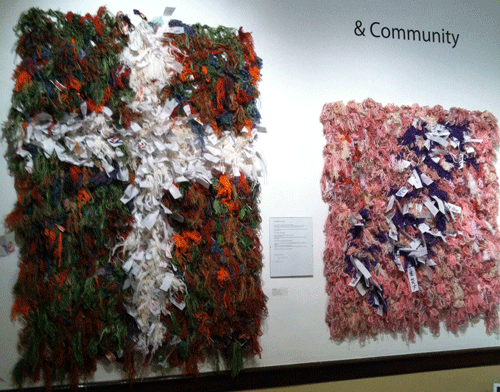
Shagging – Kathryn Pannepacker at William Way LGBT Community Center
“I’ve been known to go around and tag, make little checker boards or little, beautiful ditties, on fences and gates throughout many years. But, the last year or two in particular mostly on chain link fences. So, I got this idea, why not get a huge roll of chain link fence at Home Depot? You have to get it on line, and like an eighty pound order came, a huge roll, the idea was just to break it up and start doing huge wall pieces that I would exhibit in museums and galleries with the thought of art outside for everybody or art inside, sort of merge the two. Inside/outside. The other thing was I wanted to do large abstract painting-like pieces that were all about color and shape. Sort of like intuitive, quick and expressive.”
What do you mean quick? “Well, there’s nothing quick about textiles so I guess in a way it’s a funny way to think of it, but, it’s really just getting the juncture at the link of the fence and tying a knot and cutting it long enough so that it’s a shaggy knot.”
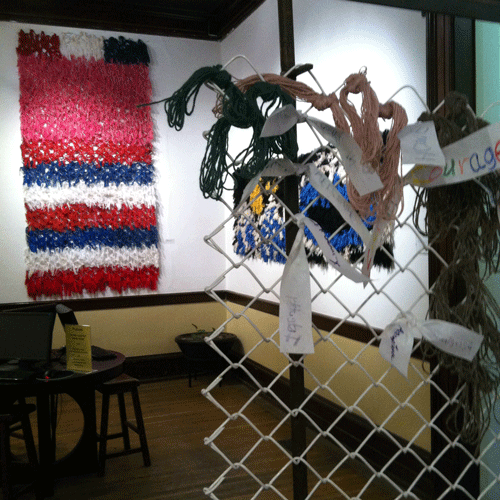
Shagging – Kathryn Pannepacker at William Way LGBT Community Center
“But, quick in the sense of, the background study that I have with with very detailed French tapestry which is pictorial flat weave, hyper-intensive timing, this was doing my own designs, simple forms and shapes, abstract, painterly-like, so, even though there’s nothing real quick about it, it’s certainly quicker than flat weave tapestry.”
DoN asked, “How do you do it? Is it hanging on the wall or do you just lay on the floor?” Kathryn Pannepacker replied, “No, I actually would hang it between a door frame or I’ve got those pipe looms, like a coat rack, or something like that, so I just hang it from there. The other thing is that people are always giving me yarns, it’s sort of like an ongoing thing. It’s kind of like a joke, that when I run out of yarn, I’m going to change careers because I’ve got this idea in my head that it should be OK that everyone changes careers at least three times in life, that should be a cultural given. Like at one point in time I would have liked to be a farmer or sell flowers on the corner. But I think when I run out of yarn I’ll switch careers but people keep giving yarn, so I’ve got more work to make.”
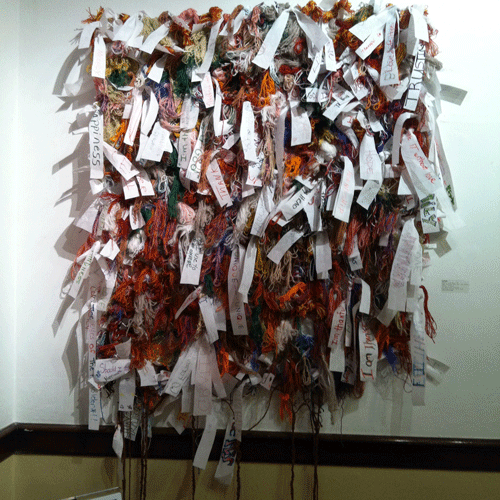
Shagging – Kathryn Pannepacker at William Way LGBT Community Center
At this point in our conversation a group of students entered the gallery and DoN followed around while Kathryn Pannepacker described the work. “Many of these pieces are done by homeless men and women or people in recovery, so we would use the pellum fabric, to ask lead-in questions like, ‘What does home mean to you?’ So, they would write their comments into the weave and add that to the fencing. The fabric is called pellum, a non-woven interfacing that a tailor might use inside of a coat. And the beauty of working with this material is that after they would write and tie a knoe you don’t necessarily read the message on it. So, it’s a nice opportunity for folks to share their thoughts and feelings but if they want to keep it private they can keep it private. So, in some of the cases they wanted to share their thoughts, so, I also recorded on a paper a list that writes it all out, like blessings, and prayers, poems and words of advice or things they’re looking forward to.”
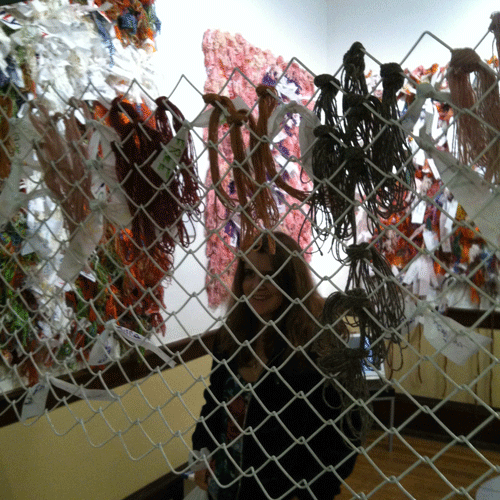
Shagging – Kathryn Pannepacker at William Way LGBT Community Center
“What gave me the idea was for a number of years I’ve been doing little weavings between fences and gates around the city, in fact, I was doing little ditty weavings between fences and gates wherever I would travel around the world and it would be a way of leaving a popcorn trail of what I was doing. So, then I started to use chain link fences around abandoned lots around the city because, around different neighborhoods where I was living, it was so depressing, I just wanted to add some color and life to that abandoned lot. I would do large, or smallish it didn’t matter, but like shags, colorful checker boards or whatever and the idea came from that and what would it take to bring that into a gallery. You might find yourself, you know, you work so much in your studio, then we work in a classroom situation, you need your own time to feed yourself or refuel. So I was like,’What’s the good link between what I’m doing in the community but also that going to inform my own personal work?”
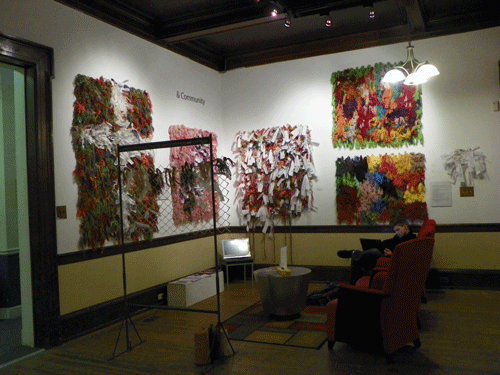
Shagging – Kathryn Pannepacker at William Way LGBT Community Center
“In fifth grade we were introduced to macrame and we were making plant hangers with macrame and so immediately after that I was doing these like wall pieces with macrame knot but then I got into latch hooking and all that, so I love all that.”
Professor of Fibers at Tyler School of Art, Pazia Mannella, was with the group of students, so DoN took the opportunity to ask her feelings about FiberPhiladelphia 2012? “I think it’s just amazing, especially someone who works in textiles and fibers, it’s so exciting to see so many examples of textile work and fiber arts work and really ranging from very traditional to experimental installation. I was at all the opening events and it’s an amazing community that is in Philadelphia.” DoN asked Professor Mannella about the political discussion surrounding women at this time and how fiber is often associated with women and her opinion of the political attack on women? “Well, I do think historically fibers has been linked with women and I think that it’s important that the voices are heard within this political realm. And that’s been kind of the issue with it being predominately men commenting on the health of women. I think that both men and women can react to a range of issues through fiber work.”
DoN commented that men seem to forget that women are taking care of business – the clothes we wear, the food we eat, the homes we live in, are often made possible by women. Professor Mannella replied, “We’re really trying to increase our enrollment of men in our area, we have a male major, and we’ve had male majors in the past, but I think there has been a bit of a stigma with the word ‘fibers’ among, at least, the men, the male student population, in my experience. But I think it’s interesting, some of the men that are taking our classes that are in their early twenties, they seem less affected by these gender debates, it’s just like there’s a difference among these young men, especially the ones in our class, they have a different point of view and they have respect for this craft and don’t feel stigmatized by it as a woman’s art. So, it’s great to see all genders working with this technique.”
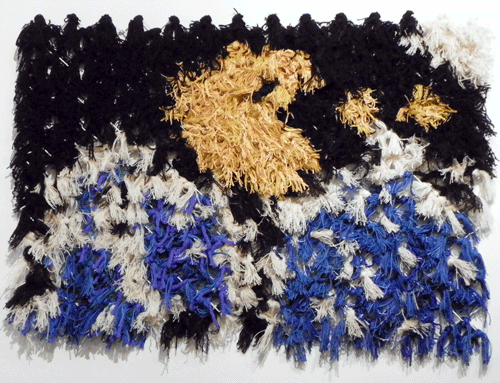
Shagging – Kathryn Pannepacker at William Way LGBT Community Center
Kathryn Pannepacker said to DoN, “I have this funny way of just using up yarn, just shagging, being textural and fun.” The art in the William Way LGBT Community Center shows influences of Mondrian and Klee, DoN wondered if this was fulfilling a need to paint? “Well, I do paint, but I don’t paint like this, I tend to paint more, sort of, art naive Matisse-like, paintings that might be narrative in a way or self portraits. I think of me rolling a ball of yarn looking at my easel, like will you take me back when I’m ready to start painting again? Because sometimes I get real affixed with weaving and then I shift over to a mural project or a painting project or get real intensely focussed with my time in community work.”
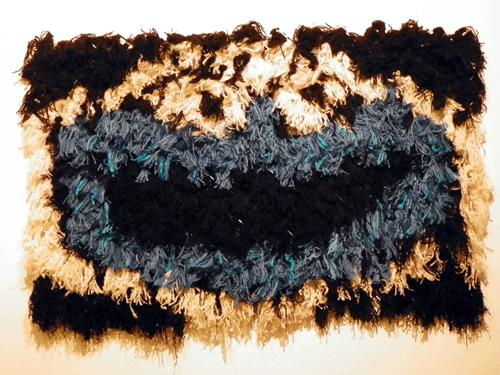
Shagging – Kathryn Pannepacker at William Way LGBT Community Center
“I wanted to share this with you, I’ve got this way of thinking, that may be a little nutsy at times, that you can’t call yourself an artist unless you’re making artwork. The whole idea of really taking care of yourself in the studio and making sure you have enough of solitude time in the studio. This work here, and the garland that’s outside the door is all part of the one-a-day series that I did. When I get really intensely focussed on a project and I get back home in the studio, I like to do a one-a-day or something that’s going to bring me to my own series of exploration – color, texture…”
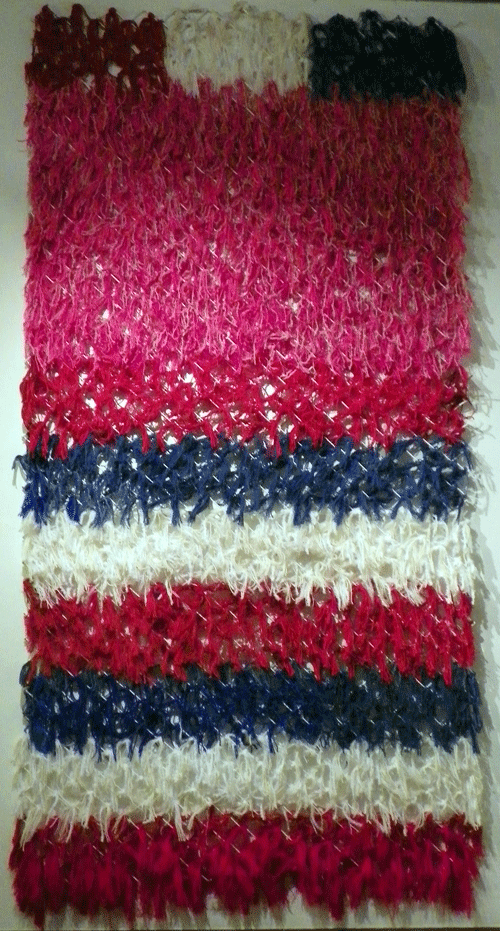
Shagging – Kathryn Pannepacker at William Way LGBT Community Center
“I got the good news about the Leeway Foundation grant, I wanted to start on my website, slowly, slowly, a blog charting the process of how I’m spending my time and what I’m doing. I have all these great ideas but for now it’s a little now and then.”
Written and photographed by DoN Brewer
Award so I want to go to Blick Art Materials
and buy a lot of markers and paper and draw things and see where that takes me.”

